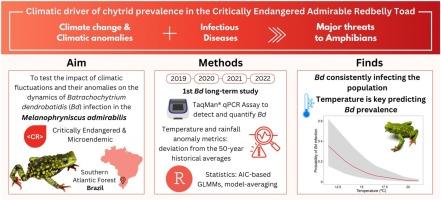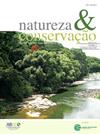极度濒危的红腹蟾蜍中壶菌流行的气候驱动因素
IF 3.5
2区 环境科学与生态学
Q1 BIODIVERSITY CONSERVATION
引用次数: 0
摘要
全球变暖正在推动降雨和温度模式的变化,预测表明气候异常的频率和强度都在增加。这些变化影响野生动物疾病动态,影响病原体发育、宿主行为、生理和疾病易感性。了解气候异常与两栖动物新出现的病原体之间复杂的相互作用,对于告知针对这一高度濒危脊椎动物群体的保护工作至关重要。因此,我们研究了在气候异常和季节气候波动的条件下,水生壶菌水蛭壶菌(Batrachochytrium dendroatidis, Bd)在微特有和极度濒危两栖动物黑腹鱼(Melanophryniscus admirabilis)体内的动态变化。此外,考虑到Bd在我们的局灶宿主物种中的亚致死效应,我们测试了Bd感染是否解释了宿主身体状况的变化。我们发现,Bd持续感染令人钦佩的红腹蟾蜍种群超过三年。我们的研究结果表明,虫病流行与季节温度之间存在联系,表明温度在虫病在蟾蜍之间传播中起着至关重要的作用。然而,我们没有发现Bd感染对宿主身体状况的影响。从这项研究中获得的见解可以改善保护工作,帮助阐明气候因素与壶菌感染之间的联系,为濒危两栖动物种群的管理计划提供信息。本文章由计算机程序翻译,如有差异,请以英文原文为准。

Climatic driver of chytrid prevalence in the Critically Endangered Admirable Redbelly Toad
Global warming is driving shifts in rainfall and temperature patterns, and projections indicate an increase in frequency and intensity of climate anomalies. These changes influence wildlife disease dynamics, affecting pathogen development, host behavior, physiology, and disease susceptibility. Understanding the intricate interplay between climatic anomalies and emerging pathogens in amphibians is essential to inform conservation efforts targeted towards this highly threatened vertebrate group. We therefore investigated the dynamics of the waterborne chytrid fungus Batrachochytrium dendrobatidis (Bd) in the microendemic and Critically Endangered amphibian Melanophryniscus admirabilis under climatic anomalies and seasonal climatic fluctuations. Additionally, considering the sublethal effects of Bd in our focal host species, we tested whether Bd infection explains the variation in host body condition. We found that Bd was consistently infecting Admirable Redbelly Toad population for more than three years. Our results point to links between Bd prevalence and seasonal temperatures, indicating that temperature plays a crucial role in Bd transmission among toads. However, we failed to find an effect of Bd infection on host body condition. The insights gained from this study can improve conservation efforts and help elucidate the links between climatic factors and chytrid infection, informing management plans for threatened amphibian populations.
求助全文
通过发布文献求助,成功后即可免费获取论文全文。
去求助
来源期刊

Perspectives in Ecology and Conservation
Environmental Science-Nature and Landscape Conservation
CiteScore
7.80
自引率
4.30%
发文量
46
审稿时长
59 days
期刊介绍:
Perspectives in Ecology and Conservation (PECON) is a scientific journal devoted to improving theoretical and conceptual aspects of conservation science. It has the main purpose of communicating new research and advances to different actors of society, including researchers, conservationists, practitioners, and policymakers. Perspectives in Ecology and Conservation publishes original papers on biodiversity conservation and restoration, on the main drivers affecting native ecosystems, and on nature’s benefits to people and human wellbeing. This scope includes studies on biodiversity patterns, the effects of habitat loss, fragmentation, biological invasion and climate change on biodiversity, conservation genetics, spatial conservation planning, ecosystem management, ecosystem services, sustainability and resilience of socio-ecological systems, conservation policy, among others.
 求助内容:
求助内容: 应助结果提醒方式:
应助结果提醒方式:


